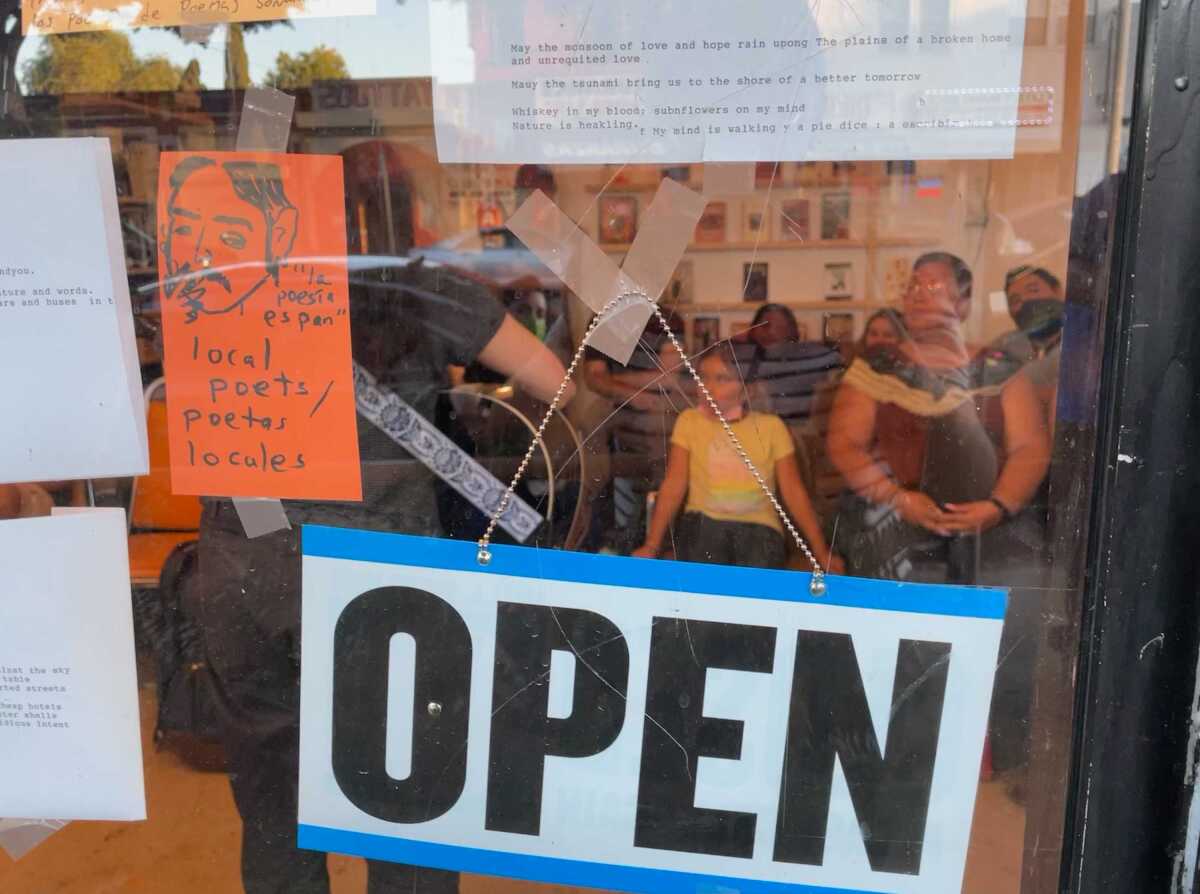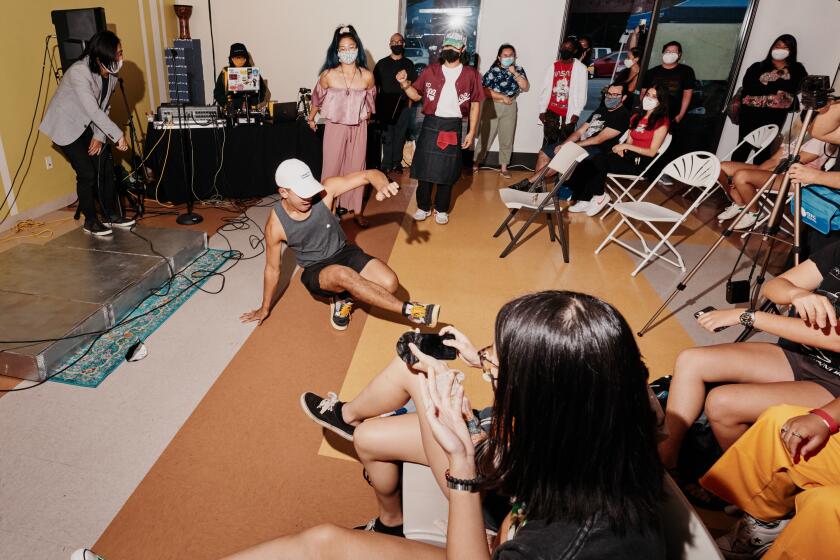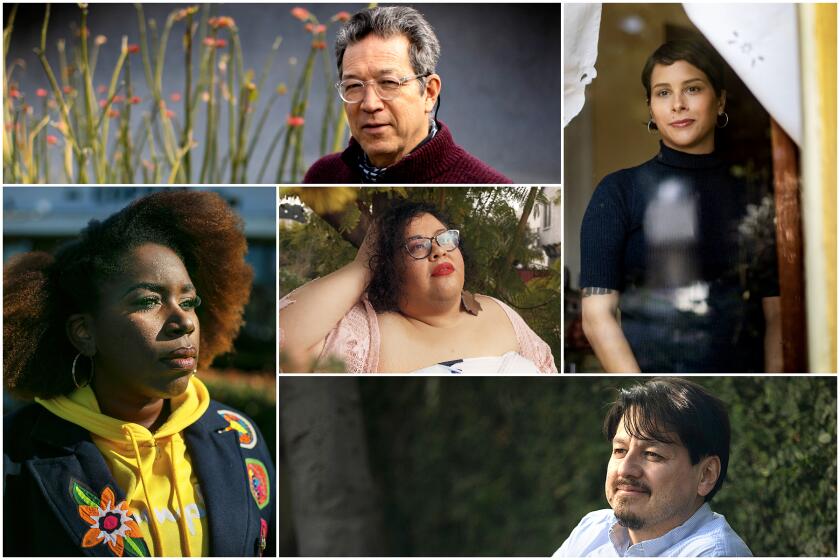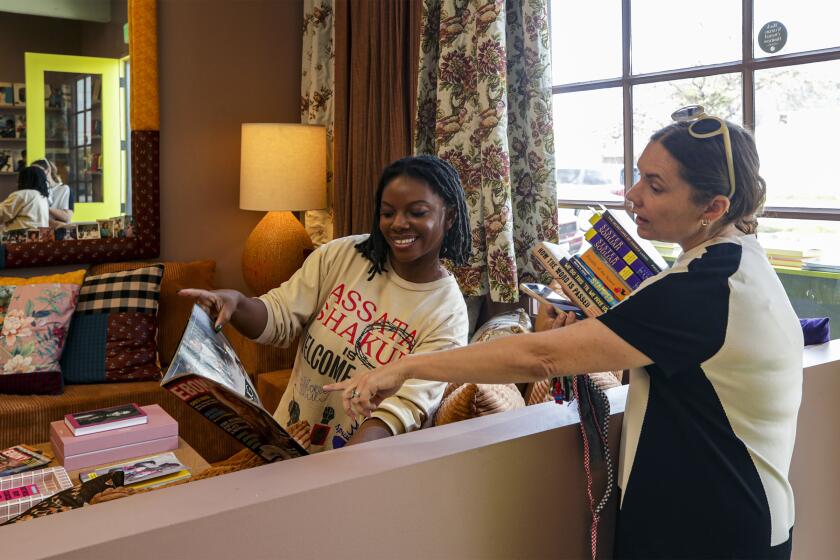New to poetry? These poets will help you get started

- Share via
Safia Elhillo was a freshman in high school when she started keeping a diary to record her heartbreaks. All of her entries were poems, so if her parent ever found them, she could hide behind the metaphors and pretend she wasn’t dating.
Younger poets of color now look up to Elhillo as a trailblazer. Her latest poetry collection, “January Children,” tackles the complications of diaspora and language rooted in her identity as a Sudanese American writer.
You don’t need a master of fine arts degree to write poetry, Elhillo said. Poetry doesn’t require more than a pen and a piece of paper.
Last summer, Elhillo led a number of free writing workshops through Not a Cult Media, the indie publisher where she’s an editor.
“It would really break my heart to feel like someone didn’t have access to poetry resources because of prohibitive costs since so many of the resources I received as a young person, that made me into a poet, were free,” said Elhillo. “So I try to offer workshop resources for free whenever possible”
Jumping into poetry can feel like high diving. Here’s some advice from Elhillo and fellow poets Matthew “Cuban” Hernandez, Alyesha Wise, Noor Hindi, Gabriel Cortez and Ariana Brown to help you overcome your fear of heights — and tell you how deep poetry flows.
From Boyle Heights to Filipinotown to the Autry Museum, venues are hosting poetry readings again, restoring a vital link between artists and their communities.
Why poetry?
Elhillo said it all began when her friend invited her to her first open mic event. As she performed, her voice shook and she lost her place a couple of times. But her words were her ticket to join the orbit of enigmatic poets who frequented poetry venues.
You might be wondering why poetry even matters. It’s a stuffy, outdated and overly complicated form of language, right? And it can be intimidating for some because of the ways we are taught poetry in school — for example, the emphasis on Shakespeare’s plays and their dense and unfamiliar dialect, or the scant attention paid to works by women and people of color.
But poetry is more than just the legacy of dead white guys (Edgar Allan Poe, Robert Frost, William Wordsworth and so on). Poets like myself, especially LGBTQ writers and poets of color, are invested in using poetry as a vehicle to appreciate the world around us today, to spark conversations and social change, and most importantly, to relate to our communities.
In contemporary poetry, you can find poets from many underrepresented communities who are commanding attention and speaking their truths.
There’s poetry about a future without oppressive policing, love poetry in the context of the doom of climate change and poetry about cancer post-surgery. You want a new flavor of poetry? Contemporary poets have it.
COVID-19 canceled in-person author readings. Now the world is reopening. We ask five L.A. poets for their takes on what lies ahead.
What counts as poetry?
Poetry exists in our everyday — even when we use similes or metaphors to tell stories to our friends — so there are no limits in how it appears in our lives. You’ve probably encountered poetry in spaces where you haven’t recognized it as such. That Bible verse by King David in Psalms? Poetry. Kendrick Lamar’s music? Poetry.
Just as poetry can be appreciated in many ways, it’s also created in different mediums. Poetry can be performed on the stage as spoken word, written on the page, sung or rapped.
There aren’t strict rules for what is poetry unless you’re trying to adhere to a specific form like the sestina, haiku or limerick. (You may also invent your own form like Terrance Hayes’ pecha kucha). In those instances, there’s a lot of poetry jargon like meter and rhyme.
Noor Hindi is a poet and journalist based in Akron, Ohio, whose poem, “F— Your Lecture On Craft, My People Are Dying,” has resonated with thousands of readers. While other poets might spend years studying the scansion of poetry, she said she’s not as interested in form.
Poetry can tackle topics as wide-ranging as nature, racism or queerness. But Hindi said it’s frustrating that the diversity of genres isn’t often recognized.
“Somebody who’s not familiar with poetry would think like Walt Whitman is in the same category as somebody like Danez Smith,” said Hindi.
Disliking a specific poem doesn’t necessarily mean you aren’t meant to appreciate poetry. It could mean you haven’t found a poem that resonates yet.
How do I get started?
Writing communities
A number of writing spaces provide free programming and are expressly for marginalized writers to find community. Many are online, making them accessible from anywhere.
For youth:
826 National
Get Lit: Words Ignite
WriteGirl
Youth Speaks
For adults:
Beyond Baroque
Black Indigenous People of Color (BIPOC) Writing Community
Dryland literary journal
The Root Slam
For all ages:
Street Poets Inc.
Spoken Literature Art Movement
I’ve been writing poetry since high school, but it wasn’t until I was given a scholarship to study with teaching artists Matthew “Cuban” Hernandez and Alyesha Wise through their L.A.-based organization Spoken Literature Art Movement (S.L.A.M.) that I began pursuing this craft seriously. Finding a writing community is one of the best ways to receive mentorship, feedback and support as you explore poetry.
Attend your local open mic events, Wise said.
Amid the pandemic and social distancing efforts, there are also virtual ways of accessing poetry, whether that’s through Instagram live, Zoom meetings or recorded YouTube performances.
Being around other poets can be infectious.
“When I feel like I don’t have any type of inspiration, I need to surround myself with poets or poetry,” said Cuban.
Poets recommend
Matthew “Cuban” Hernandez recommends “The Splinter Factory” by Jeffrey McDaniel: It was one of the first poetry books I read. Also, it’s a fun, wild read that will captivate the eyes and mind of almost anyone.
Alyesha Wise recommends “Bicycles: Love Poems” by Nikki Giovanni: First of all, my first poetry book recommendation will almost always be a Black woman. Secondly, Nikki Giovanni’s writing does not miss. And last, but not least, everyone is intrigued by love.
Gabriel Cortez recommends “Whereas” by Layli Long Soldier: I first read “Whereas” on an early morning commute to a school I taught at, and I was so into it I missed my bus stop! But I wasn’t even mad because the author’s exploration of history and power and language — down to the level of syllable — inspired me to kick one of my greatest freestyles of all time on my walk back. I love a book that makes me overflow with language, that inspires me to find new ways of telling my story by offering me new ways of listening.
Cortez also recommends “Blood Dazzler” by Patricia Smith: Patricia Smith is one of the most important poets that participated in poetry slam, and she has taught many of us following behind her what it looks like to find your voice on the page. In this collection, Smith writes about and to and from Hurricane Katrina, using the superpowers of the poet to make the reader confront the impact of ongoing climate change catastrophe in a way that data and statistics can’t on their own.
Ariana Brown recommends “love conjure/blues” by Sharon Bridgforth: One of my favorite writers is Sharon Bridgforth. Her work straddles the line between poetry, fiction and plays. Her book “love conjure/blues” is a collection of oral stories about queer and genderqueer Black folks in the South, and I love how she weaves themes of ancestry, love, kinship, survival and life into everyday stories and poetic language. I highly recommend it.
Hearing good writing and performance can encourage us to write ourselves.
Hindi remembers reading Tarfia Faizullah‘s poetry for the first time and the power of feeling seen through Faizullah’s writing in a new and unexpected way.
“It was honestly the first time that I had seen someone — contemporary and alive writing right now as I was living — who captured a part of my life,” said Hindi.
When writing a new poem, Gabriel Cortez, the director of programming at Youth Speaks and co-founder of The Root Slam based in the Bay Area, encourages his students to break down their preconceived notions of how a poem or a poet is supposed to sound.
It’s okay if you don’t leave his classes identifying as a poet, Cortez said. What’s more important to him is empowering people with the words to make a difference in their lives and in their communities.
“I want folks to come out of the space feeling a little bit more confident in telling their story,” said Cortez. “We believe in the necessity of everyone to speak up in order for movements for justice to work.”
Start following poets you like and to see what events they do so you can study their work.
Ariana Brown, a poet from San Antonio, has reached hundreds of thousands with their words online, and last summer they invited their followers for free live writing workshops on YouTube.
In Youth Speaks writing workshops, Cortez reminds young writers, “the standard is yourself,” to encourage them to challenge themselves without feeling the weight of comparing their work.
It’s the honesty of your work that matters most, Wise said. If they are having writer’s block, she encourages writers to tap into their joy and playful spirit.
“Whatever you’re feeling, if it comes from a genuine place, just say it,” said Wise. “There’s so much magic and glory [in our subconscious].”
How can you share your poetry?
Maybe you’re a hobbyist like me who’s now serious about writing poetry. When Youth Speaks published three of my poems in its anthology “Between My Body and the Air” and had me interview a poet for the organization’s Instagram live feed, it gave me the confidence to call myself a working artist.
Some poets like Yesika Salgado or Rupi Kaur share their poetry online on Instagram, while others might publish their work exclusively in journals. Eventually, you may work up to a full-length book.
Publishing poems in print anthologies and periodicals makes it more difficult for readers to access a poem unless they purchase a copy, but that’s where writers and editors are more likely to be compensated for their work. And the prestige around a publication may earn you a reputation.
Online journals are more widely accessible and writers and editors may also be compensated, depending on the publication. But journals might have submission fees and long waiting periods before review.
This may be why Instapoetry has gained traction in recent years.
Instagram is an easy and accessible way to share your art with a larger audience. Lines can be pithy and eye-grabbing in ways that make the words digestible on a visually-based medium. For both the reader and the artist, there’s immediate feedback and conversation which can be both refreshing and encouraging.
If you’re set on publishing in journals, Hindi says a great place to start is to look in your favorite poetry books’ acknowledgment section, which is where writers typically thank the journals that initially published their poems. It’s best to familiarize yourself with the journals and publishers you are interested in submitting to. Learn whether the publisher allows you to submit your poems to other outlets while you’re waiting to be accepted or rejected. It’s also great to keep track of where and when you’ve submitted. Once a poem has been accepted, you’ll need to notify other journals and withdraw your poem from their publications.
As we’re gaining a better awareness of poetry, we might think of some works as “bad” and others as “good.” But Brown doesn’t attempt to place labels on poems because everyone has distinct preferences.
“Every poem’s goal is different,” said Brown. “People are allowed to write about and be interested in whatever they want, as long as it’s not harmful or exploitative.”
After a brutal year of economic uncertainty, booksellers in L.A. are expecting a full recovery. But the June 15 reopening is reigniting safety concerns.
More to Read
Sign up for our Book Club newsletter
Get the latest news, events and more from the Los Angeles Times Book Club, and help us get L.A. reading and talking.
You may occasionally receive promotional content from the Los Angeles Times.












